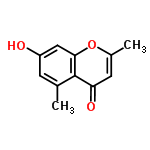
| |
| Names | |
|---|---|
| IUPAC name
7-hydroxy-2,5-dimethyl-4H-chromen-4-one
| |
| Other names
Altechromone A
| |
| Identifiers | |
3D model (JSmol)
|
|
| ChemSpider | |
PubChem CID
|
|
| |
| |
| Properties | |
| C11H10O3 | |
| Molar mass | 190.195 |
Except where otherwise noted, data are given for materials in their standard state (at 25 °C [77 °F], 100 kPa).
| |
Altechromone A is a chromone derivative. To date, it has been isolated from plant families such as Polygonaceae, Lamiaceae, Fabaceae, and Hypericaceae.
Isolation
editAltechromone A was isolated from an Alternaria sp. in 1992. It has since been isolated from fungi species such as Hypoxium trancatum, Ascomycota sp., and Alternaria brassicicola. Researchers have come to the conclusion that Altechromone A is a common fungal metabolite with its origin in endophytic fungi.[2]
Potential uses
editFor thousands of years, humans have used endophytic species in traditional medicines. Since Louis Pasteur began investigating microbes, science has further revealed the potential benefits of these compounds.[3] Researchers noted that this compound demonstrates both root growth promotion and inhibits bacterial production. Penicillin and other antibiotics effectively treated microbial infections. However, antibiotic misuse has resulted in resistence of pathogens to antimicrobial agents. Altechromone A could provide a source of antimocrobial agents that microbes have yet to develop a resistence to.[4] In addition, the compound could posses anti-tumor capabilities thus yielding more potential medical applications.[5]
References
edit- ^ "2,5-Dimethyl-7-hydroxy chromone". ChemSpider. Royal Society of Chemistry. Retrieved April 18, 2011.
- ^ Konigs, P. (November 17, 2010). "Structural Revision and Synthesis of Altechromone A". Journal of Natural Products. 12. 73: 2064–2066. doi:10.1021/1005604 (inactive 2023-08-02).
{{cite journal}}: Unknown parameter|coauthors=ignored (|author=suggested) (help)CS1 maint: DOI inactive as of August 2023 (link) CS1 maint: date and year (link) - ^ Strobel, Gary; Daisy, Bryn (December 2003). "Bioprospecting for Microbial Endophytes and Their Natural Products". Microbiology and Molecular Biology Reviews. 4. 67 (4): 1092–2172. doi:10.1128/MMBR.67.4.491-502.2003. PMC 309047. PMID 14665674.
{{cite journal}}: CS1 maint: date and year (link) - ^ Gu, Wen (May 23, 2009). "Bioactive metabolites from Alternaria brassicicola ML-PO8, an endophytic funus residing in Malus halliana". World J Microbial Technology. 25 (9): 1677–1683. doi:10.1007/s11274-009-0062-y.
{{cite journal}}: CS1 maint: date and year (link) - ^ Gu, W.; Ge, H. M.; Song, Y. C.; Ding, H.; Zhu, H. L.; Zhao, X. A.; Tan, R. X. (December 24, 2006). "Cytotoxic Benzo[j]fluoranthene Metabolites from Hypoxylon truncatum IFB-18, and Endophyte of Artemisia annua". Journal of Natural Products. 1. 70: 114–117. doi:10.1021/np0604127. PMID 17253861.
{{cite journal}}: CS1 maint: date and year (link)